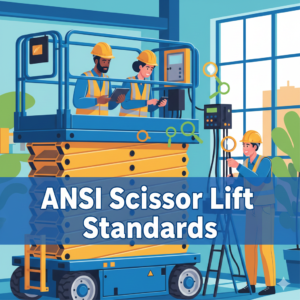For the most difficult heavy jobs in the air, a gas powered scissor lift is one of the most dependable and effective solutions you can get. These vehicles offer great lifting capacity, mobility, and adaptability, which make them the perfect tools for building, storage, and industrial works.
This exhaustive manual will uncover:
- The concept of a gas-powered scissor lift and the working principle
- The main features compared to electric or diesel models
- The leading uses in different sectors
- The considerations to be taken into account before making a purchase
- The maintenance and safety tips
Essentially, you will be able to pick the right gas-powered scissor lift for your requirements once you have gone through all the details here.
What Is a Gas Powered Scissor Lift?
A gas powered scissor lift is a mobile elevated work platform (MEWP) that utilizes an internal combustion engine (generally gasoline or propane) to power its hydraulic system. Compared to electric ones, which are battery-powered, gas models have higher power and longer working hours, thus they can be used for outdoor and rough-terrain works.
How Does a Gas Powered Scissor Lift Work?
- Engine Power: The gas engine turns the hydraulic pump that manages the scissor system.
- Hydraulic Lift System: When the hydraulic fluid is pressurized, the scissor arms are extended, lifting the platform.
- Mobility: In fact, most gas-powered scissor lifts are equipped with either rugged tires or all-terrain capabilities which enable them to function on uneven surfaces.
Key Benefits of Gas Powered Scissor Lifts
1. High Power & Performance
- Made for heavy activity with a capability to lift from 500 to 5,000+ lbs.
- More suitable for outdoor use than electric models.
2. Extended Runtime
- Non-stop work can be done without the need for frequent recharging, just refuel and keep working.
- Great for long hours or remote locations without electricity.
3. Versatility in Terrain
- Such gas powered scissor lifts are often equipped with rough-terrain tires, thus, are firm on unlevel ground.
- The machines are versatile in nature, therefore, can be used in the fields of construction, agriculture, and outdoor maintenance.
4. Faster Operation
- Gas powered lifts are faster in ascending and descending as compared to electric ones.
- More efficient use of the working hour for the projects that are time-sensitive.
5. Cost-Effective for Heavy Use
- In some instances, the cost for the installation of a diesel alternative is relatively higher than that for a gas one.
- There is more time for work because there is no need for charging the battery.
Common Applications of Gas Powered Scissor Lifts
1. Construction Sites
- The main activities were the installation of steel frames, the setting up of the roof, and the fitting of the HVAC system.
- Work that could not normally be carried out at a height was facilitated.
2. Warehousing & Logistics
- Items were placed on very high shelves, in large distribution centers, to maximize the use of space.
- The heavy materials were taken off and put on the vehicles.
3. Outdoor Maintenance
- These were some of the works that took place:
- the trimming of the trees, the installation of the signs, and the repair
4. Industrial Facilities
- These include plant maintenance, machine repair, and assembly line modifications.
- Operation of heavy machinery at a factory.
Factors to Consider When Buying a Gas Powered Scissor Lift
1. Lift Height & Capacity
- Figure out the greatest working height that is needed.
- Weight capacities should be looked at to provide support for workers, tools, and materials.
2. Engine Type (Gasoline vs. Propane)
- Gasoline: More powerful but gives off more fumes (better for outdoor use).
- Propane: A cleaner burning engine that can be used in a semi-enclosed space.
3. Terrain Compatibility
- The rough-terrain models are equipped with larger tires and have greater stability.
- Standard pneumatic tires may suffice for smooth surfaces.
4. Fuel Efficiency & Emissions
- The newly built models meet the EPA emissions standards.
- It is good to look at how much fuel is consumed for long-term savings.
5. Safety Features
- Be on the lookout for emergency stop buttons, tilt sensors, and guardrails.
- They also help if they are fully compliant with the OSHA and ANSI standards.
6. Brand Reputation & Support
- Brands that are reputable and well-known such as Genie, JLG, and Skyjack usually give you the confidence that their products are reliable.
- It is also important to check how accessible the
Maintenance Tips for Gas Powered Scissor Lifts
1. Regular Engine Checks
- Changing oil and filters is an essential part of the process.
- Examine spark plugs and fuel lines for wear.
2. Hydraulic System Care
- Monitor fluid levels and watch out for leaks.
- Change hydraulic filters regularly.
3. Tire & Chassis Inspection
- Make sure the tires are properly inflated and without any damage.
- Apply lubricant to the moving parts to prevent the production of rust and wear.
4. Battery & Electrical Components
- Even gas cars have batteries for ignition—keep them charged.
- Check all the functionalities, including the emergency ones, regularly.
5. Storage Best Practices
- Keeping a vehicle in a dry and covered place can help in avoiding weather damage.
- The engine should be run for a while if the vehicle is not going to be used in the coming days.
Safety Guidelines for Operating Gas Powered Scissor Lifts
1. Pre-Operation Inspection
- Before each use, fluids, tires, and controls should be checked.
- Make sure there are no leaks or mechanical issues.
2. Proper Training & Certification
- Only the personnel who have received the necessary training should be in charge of the lift.
- Comply with the standards of OSHA and the manufacturer.
3. Load Management
- Do not go over the maximum weight allowed under any circumstances.
- The weight on the platform should be even.
4. Stability & Positioning
- Do not operate the machine on steep slopes or unstable ground.
- Extend the stabilizers if you have them for more safety.
5. Fall Protection
- It is a must for workers to have and wear their harnesses at all times when the situation requires so.
Conclusion
A gas powered scissor lift is an excellent and multifunctional machine that is suitable for any kind of industry that requires reliable access to the air. Among the advantages that these lifts have, are; high performance, long operating time, and a rugged mobility, thus, in outdoor and heavy works, these lifts can even outperform electric ones.
Before buying, it is advisable to take into account the following aspects; the height of the lift, the type of engine, the characteristics of the terrain, and some safety features. Correct maintenance and the observance of safety regulations will guarantee the safety of the operator and the long-term work of the machine.
If you work in the field of construction, warehousing, or industrial maintenance, the decision to purchase a high-quality gas-powered scissor lift will be a significant positive change in the productivity and safety of the work at the site.





